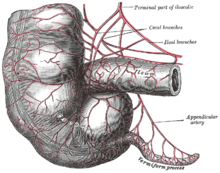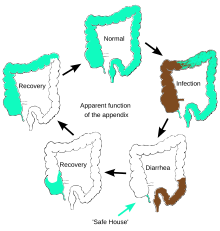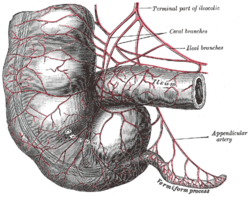Apendix

Apendix (též červovitý přívěsek slepého střeva či appendix vermiformis) je rudimentální dlouhý tenký výběžek s volným koncem, obvykle 6–10 cm dlouhý a asi 7 mm široký, který vychází ze slepého střeva. Jeho stěna obsahuje lymfatickou tkáň, která zřejmě slouží jako lokální mízní uzlina. Na rozdíl od tlustého střeva je apendix pokryt souvislou svalovinou.
Jelikož konec apendixu je volný, může tento výběžek zaujímat různé polohy. Neobvyklé polohy apendixu mohou ztížit správnou diagnózu při zánětu, neboť pacient reaguje na palpační vyšetření jinak a bolest je jinak lokalizována.
Slepé střevo a jeho apendix se nacházejí na pravé straně těla (při pohledu z očí pacienta). Přibližně u jednoho z 10 000 lidí (se stranově převrácenými vnitřními orgány; situs inversus) může být na levé straně. Zhruba jeden člověk z 100 000 apendix nemá (tzv. vrozená absence).
k obnovení tělu prospěšných bakterií po průjmu
Jednou z funkcí apendixu je rezervní zásobárna mikrobiomu střeva, tedy tělu prospěšných symbiotických bakterií. Při destrukci mikrobiomu střevní infekcí dochází k obnově mikrobiomu z apendixu.[1][2] Odstraněním apendixu zřejmě stoupá riziko infekce bakterií Clostridioides difficile,[3] která může způsobit infekci střeva, často vznikající potlačením normální střevní flóry antibiotiky.
Onemocnění
Odkazy
Reference
- ↑ Associated Press. Scientists may have found appendix's purpose. NBC News. 5 October 2007. Dostupné v archivu pořízeném z originálu dne 4 February 2020.
- ↑ Randal Bollinger R, Barbas AS, Bush EL, Lin SS, Parker W. Biofilms in the large bowel suggest an apparent function of the human vermiform appendix. Journal of Theoretical Biology. December 2007, s. 826–31. DOI 10.1016/j.jtbi.2007.08.032. PMID 17936308.
- ↑ DUNN, Rob. Your Appendix Could Save Your Life [online]. Scientific American, January 2, 2012 [cit. 2016-12-22]. Dostupné v archivu pořízeném z originálu dne 11 November 2020.
Literatura
- ABRAHAMS, Peter H. a DRUGA, Rastislav, ed. Lidské tělo: atlas anatomie člověka. 1. čes. vyd. Praha: Cesty, 2003. 256 s. ISBN 80-7181-955-7.
Externí odkazy
 Obrázky, zvuky či videa k tématu apendix na Wikimedia Commons
Obrázky, zvuky či videa k tématu apendix na Wikimedia Commons  Galerie apendix na Wikimedia Commons
Galerie apendix na Wikimedia Commons Slovníkové heslo apendix ve Wikislovníku
Slovníkové heslo apendix ve Wikislovníku
Média použitá na této stránce
(c) WebHamster na projektu Wikipedie v jazyce angličtina, CC BY-SA 3.0
Conversion to SVG format of existing diagram in JPG format.
Original author
Apparent function of the human vermiform appendix in the recovery from diarrhea. (J. Theoretical Biology. doi:10.1016/j.jtbi.2007.08.032) The colon with normal, beneficial bacteria (green color) is contaminated with an organism (brown color) that causes diarrhea. The appendix apparently serves as a "safe house" for the good bacteria, protecting that supply of bacteria from contamination and facilitating a re-start of the system once the contaminating organism has been eliminated. (J. Theoretical Biology. doi:10.1016/j.jtbi.2007.08.032) Although more than 2 million children die each year in developing countries as a result of diarrhea, children living in those countries face an estimated 1.4 billion cases of diarrhea each year (Information based on data from the Centers for Disease Control and Prevention (CDC) as published in Emerg Infect Dis 9(5), 2003.) Thus, the process of recovery from diarrhea is relatively effective in developing countries. This process is expected to be less critical in developed countries, where widespread epidemics resulting in diarrhea are uncommon and thus the loss of beneficial bacteria from the population as a whole is highly unlikely. (J. Theoretical Biology. doi:10.1016/j.jtbi.2007.08.032)
Popis
Conversion to SVG format of existing diagram in JPG format. Original author


